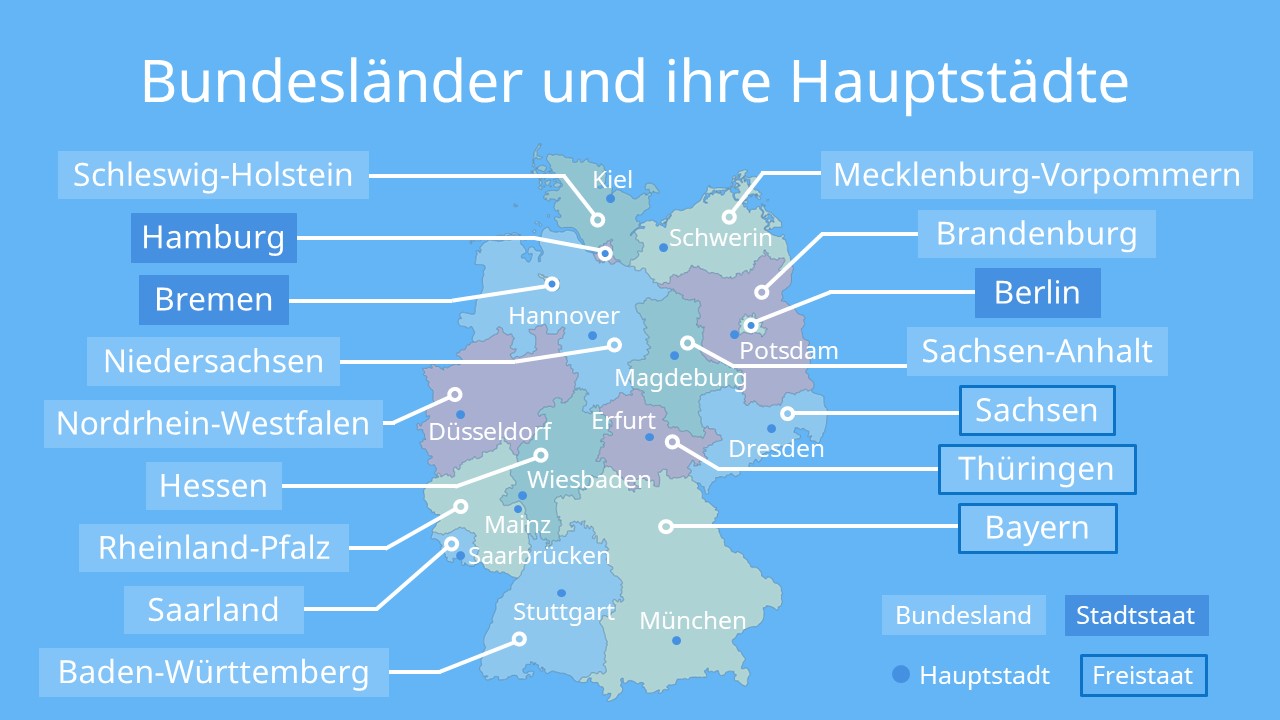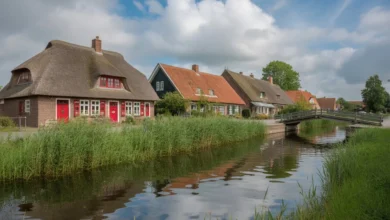Bundesländer Deutschland Mit Hauptstadt: The 16 German Federal States and Their Capitals

Bundesländer deutschland mit hauptstadt here’s a friendly expert-style guide to all of Germany’s federal states (Bundesländer) and their capitals, with a bit of context to make them memorable. Each heading covers one state briefly, giving you its name, its capital, and some interesting remarks on regional flavour, historical role or quirky fact.
1. Baden-Württemberg — Stuttgart
Baden-Württemberg is situated in the south-west of Germany and is one of its major industrial and innovation hubs. The capital, Stuttgart, is well known as the home of major automotive companies and a beautiful green city with vineyards near its urban core.
Stuttgart has served as the centre of political administration for Baden-Württemberg since the state’s founding in 1952, when the former states of Baden, Württemberg-Baden and Württemberg-Hohenzollern merged.
The state blends Swabian tradition, solid engineering, and scenic countryside — making it a powerhouse while also offering charming towns outside the big city.
2. Bavaria (Bayern) — Munich (München)

Bundesländer deutschland mit hauptstadt Bavaria, called Bayern in German, is Germany’s largest federal state in terms of area. Its capital, Munich (München), is internationally famous for its culture, Oktoberfest, beer gardens, alpine proximity and strong economy.
Even though Bavaria is stereotypically “beer and lederhosen,” it’s also a high-tech region with large media, automotive and aerospace industries. The regional identity is strong: many Bavarians emphasise their “Freistaat” status (literally “free state”).
Munich combines historic architecture, modern business districts, and a quality of life that attracts both German and international residents. It also serves as a cultural magnet in Germany.
3. Berlin — Berlin
Berlin is one of three so-called “city states” (Stadtstaaten) in Germany, meaning the city and the state are one and the same. The capital of Germany is also its own federal state: Berlin.
Because of this unique dual role—as national capital and federal state—it plays a highly visible role in politics, culture, education and international affairs.
Berlin’s history is extraordinary: from being divided by the Berlin Wall to becoming a vibrant and diverse metropolis uniting east and west. Its status as both city and state gives it special administrative structure and identity.
4. Brandenburg — Potsdam
Brandenburg surrounds Berlin and has its capital at Potsdam, a city with rich history, palaces and park landscapes (such as Sanssouci).
Potsdam offers an interesting counterpoint to the metropolis of Berlin: historical grandeur meets green spaces, lakes and calmer pace. The state of Brandenburg has many rural and natural areas, and its proximity to Berlin means it often plays a supporting role in economy, commuting and culture.
Historically, Brandenburg was part of the Margraviate of Brandenburg and later the Kingdom of Prussia. Today, it is evolving towards technology, tourism and sustainable regional development.
5. Bremen — Bremen
The state of Bremen is another city-state: basically the city of Bremen plus Bremerhaven. The capital is Bremen (officially the Free Hanseatic City of Bremen).
Given its compact size, Bremen’s identity is deeply linked to maritime heritage, trade (Hanseatic history) and port economy. While small compared to other states, it punches above its weight in shipping, logistics and innovation.
As a city-state, its government, urban life and state services all come together—in effect you could say “Bremen city = Bremen state,” which simplifies certain legal and administrative layers.
6. Hamburg — Hamburg
Hamburg is the third city-state of Germany. The Free and Hanseatic City of Hamburg serves both as a major maritime port and as a vibrant metropolitan centre with rich culture, music and nightlife.
Its capital is, naturally, Hamburg itself. With the Elbe River cutting through, harbours, canals and water-based scenery are integral to the city’s atmosphere.
Hamburg’s state-level government has to handle city planning, state policy and urban dynamics all at once. The result: a cosmopolitan, waterfront-oriented state that’s distinct from the typical “Bundesland” image of countryside plus city.
7. Hesse (Hessen) — Wiesbaden
Hesse (Hessen) sits in central Germany, with Wiesbaden as the state capital. Often overshadowed by nearby Frankfurt (which is the largest city in Hesse but not the capital), Wiesbaden offers spa history (it’s one of Europe’s oldest spa towns) and administrative significance.
The state plays a pivotal role in finance, transport and logistics, primarily due to Frankfurt’s airport and the Rhine-Main region. But in terms of governance and regional culture, Wiesbaden anchors Hesse’s government institutions.
Hessen’s central location means it’s often a crossroads of business, culture and mobility, bridging northern and southern Germany.
8. Mecklenburg-Vorpommern — Schwerin
Mecklenburg-Vorpommern lies in the north-east of Germany, neighbouring the Baltic Sea and characterised by coastlines, lakes and swamps. The capital, Schwerin, is somewhat modest in size but very picturesque, with its famous castle and lake setting.
This state offers a slower rhythm compared to Germany’s industrial heartlands: tourism, nature, and heritage are strong. Mecklenburg-Vorpommern is often chosen by people seeking calm, water and nature rather than big-city hustle.
Politically and economically, it’s navigating post-reunification transitions, population decline and the shift to service/tourism industries—but the scenery and lifestyle make it uniquely appealing.
9. Lower Saxony (Niedersachsen) — Hanover (Hannover)
Lower Saxony (Niedersachsen) is in north-western Germany. Its capital is Hanover (Hannover). The state covers a large area and has a diverse economy—agriculture, manufacturing, automotive and more.
Hanover itself is a central node for trade fairs (CeBIT, Hannover Messe), logistics and regional governance. The state has both urban centres and expansive rural regions, making it a microcosm of Germany’s variety.
Niedersachsen’s coastline along the North Sea, the plains, and the inland hills contribute to its geographic diversity, and its state government often balances urban-industrial development with rural preservation.
10. North Rhine-Westphalia (Nordrhein-Westfalen) — Düsseldorf
North Rhine-Westphalia (Nordrhein-Westfalen) is Germany’s most populous state and one of its most economically significant. Its capital is Düsseldorf.
This state is home to the Ruhr region (formerly heavy industry zone), as well as vibrant cities like Cologne, Dortmund, Bonn and Düsseldorf. The region has transitioned from heavy manufacturing to services, tech and culture.
Düsseldorf, while not the largest city in the state, is known for fashion, trade fairs, and as a headquarters city; the state as a whole embodies the transformation of German industry and the diversity of urban life.
11. Rhineland-Palatinate (Rheinland-Pfalz) — Mainz
Rhineland-Palatinate, called Rheinland-Pfalz, lies in western Germany, with Mainz as its capital. Known for wine regions (Mosel, Rhine Valley), castles and historical towns, the state combines scenic beauty with industry and agriculture.
Mainz itself has Roman roots, a strong media presence and a lively cultural calendar. The state government convenes there, even though some of its largest economic hubs lie elsewhere in the region.
Rheinland-Pfalz bridges Germany’s wine-making tradition, river valley landscapes, and modern tech/manufacturing sectors—giving it a mixed but distinctive profile.
12. Saarland — Saarbrücken
Saarland is a small state in western Germany, bordering France. Capital: Saarbrücken. Historically, Saarland has had a unique role—entering and leaving French administration, integrating coal and steel industries, and now shifting into services and cross-border cooperation.
Saarbrücken combines German and French cultural influences, and the state’s compact size makes it particularly community-oriented. For someone interested in border-land dynamics and regional innovation, Saarland is intriguing.
Though small, Saarland plays a role in Europe’s cross-border economy, and its identity reflects both German regional tradition and Franco-German connection.
13. Saxony (Sachsen) — Dresden
Saxony (Sachsen) is in eastern Germany, capital Dresden. Known for its Baroque architecture, rich cultural heritage (e.g., Frauenkirche), and industrial and technological prowess (especially in microelectronics and optics).
Dresden is reborn after wartime destruction and reunification, offering a mix of historic elegance and modern high‐tech centres. The state blends tradition with innovation.
Saxony’s regional culture is strong, rooted in craftsmanship, music (think Bach and Mendelssohn in Leipzig too), and a certain eastern German resilience after 1990’s changes.
14. Saxony-Anhalt (Sachsen-Anhalt) — Magdeburg
Saxony-Anhalt (Sachsen-Anhalt) sits in central eastern Germany; the capital is Magdeburg. Often overlooked, this state nonetheless has tremendous heritage (e.g., the Magdeburg Cathedral, Luther’s path), and a countryside that reflects the quieter side of Germany.
Magdeburg has had to adapt to demographic change, economic restructuring and efforts to invigorate regional growth. It’s an example of places remaking their identity in a modern Germany.
The state’s advantages: cultural landmarks, natural landscapes, and a strategic central location. Its challenge: translating those advantages into sustained growth.
15. Schleswig-Holstein — Kiel
Schleswig-Holstein occupies the very north of Germany, sandwiched between North Sea and Baltic Sea, with capital at Kiel. Maritime climate, shipping history (Kiel week), islands and coastline dominate its character.
Kiel is the state’s political and economic hub, and its location gives it a distinct identity: border with Denmark historically, rural/fishing communities, and coastal tourism. The state offers a lifestyle that many mainland states don’t: sea breezes and flat landscapes.
It also illustrates one of Germany’s more relaxed states, away from the big industrial belts, yet still fully integrated into national infrastructure and governance.
16. Thuringia (Thüringen) — Erfurt
Thuringia (Thüringen) is in central Germany, with Erfurt as capital. Known as the “green heart” of Germany thanks to its forested hills, historic towns (Weimar, Jena), and cultural heritage (Goethe, Schiller) the state offers a blend of culture and nature.
Erfurt serves as the administrative centre, and the state was part of former East Germany. Since reunification it has been working hard on infrastructure, education and regional economic revival.
Thuringia’s advantage: central location, natural beauty, and strong tradition in education and research (e.g., in Jena). Its modern challenge: keeping young talent and balancing urban and rural areas.
Why This List Matters
Understanding the 16 German federal states and their capitals is more than memorising names. It gives insight into Germany’s federal structure, regional diversity, and historical layers. Each state has its own government, constitution, and responsibility for many internal affairs (education, policing in part, culture, infrastructure) under the umbrella of the national constitution.
The capitals (Landeshauptstädte) serve as administrative centres, often reflecting regional identity, political importance and historical significance. For learners of German geography, this list provides a backbone for exploring culture, economy and society.
Also, the existence of three city-states (Berlin, Hamburg, Bremen) adds an interesting twist: these are states that are simply cities, giving them a unique status compared to the larger territorial states.
Pro Tips for Remembering Them
- Think regionally: group by north (Schleswig-Holstein, Mecklenburg-Vorpommern), east (Saxony, Saxony-Anhalt, Thuringia, Brandenburg), south (Bavaria, Baden-Württemberg) and west (North Rhine-Westphalia, Rhineland-Palatinate, Saarland, Hesse) to embed geography plus names.
- Note the city-states: Berlin, Hamburg, Bremen—these are easier to remember because the city = the state.
- Relate capital to region: E.g., Munich = Bavaria, Kiel = Schleswig-Holstein (north), Potsdam = Brandenburg (east near Berlin).
- Use context: Which states border which other countries? Which capitals were historic seats? Which states are more rural vs. urban? These details help solidify the pairs in your memory.
Final Thoughts
Germany’s federal system is rich and diverse. Each state brings its own flavour, history, economy and culture. By knowing all 16 states and their capitals, you gain a window into how modern Germany is composed—not just as a single unit, but a collection of regions cooperating yet distinct.
Whether you’re learning German, preparing for geography, travelling or just broadening your knowledge, this list is a foundational building block.
In short: remember Bundesland — Hauptstadt pairs and then dig into what makes each state special. The capitals are more than administrative dots on a map—they are cultural hubs, historic centres and living expressions of regional identity.
Hope you found this overview helpful. If you like, I can provide a neat table listing all the states with their capitals plus key stats (population, area, region) for quick reference.

